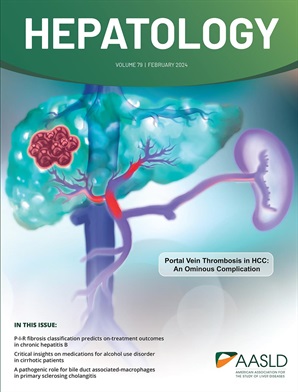FXR splicing by SF3B3 promotes MYC-driven hepatocarcinogenesis.
IF 15.8
1区 医学
Q1 GASTROENTEROLOGY & HEPATOLOGY
引用次数: 0
Abstract
BACKGROUND AND AIMS Dysregulation of the MYC oncogene is a major genetic event in hepatocellular carcinoma (HCC). Farnesoid X receptor (FXR), a bile acid (BA) receptor, has emerged as a promising therapeutic target for various liver diseases. Both BA composition and FXR isoforms have been shown to be significantly altered in human HCCs. This study aimed to investigate their potential roles in MYC-driven hepatocarcinogenesis. APPROACH AND RESULTS HCC was induced in mice by hydrodynamic injection with MYC and MCL1 oncogenes. UPLC-MS/MS analysis revealed elevated BA levels, particularly primary conjugated BAs, in both serum and livers of MYC-driven HCC mice. qPCR and western blot analyses demonstrated suppression of BSEP and dysregulation of FXR splicing in the livers of these mice. Using RNA antisense purification coupled with mass spectrometry (RAP-MS), the splicing factor SF3B3 was identified as a regulator of FXR splicing. Both in silico and in vitro studies confirmed that SF3B3 is a direct downstream target of MYC in mice and humans. Functionally, overexpression of Fxrα2 and Fxrα4 or deletion of Sf3b3 significantly impeded MYC-driven hepatocarcinogenesis in mice. Moreover, combination treatment with a SF3B inhibitor and an FXR agonist synergistically suppressed proliferation of HCC cells. Analysis of clinical HCC samples revealed a positive correlation between SF3B3 and the relative expression of FXRα2. CONCLUSIONS SF3B3 is a key downstream effector of MYC-driven hepatocarcinogenesis and a critical regulator of FXR splicing. Both SF3B3 and FXR represent druggable vulnerabilities in MYC-amplified HCC.SF3B3的FXR剪接促进myc驱动的肝癌发生。
MYC癌基因的失调是肝细胞癌(HCC)的一个主要遗传事件。Farnesoid X受体(FXR)是一种胆汁酸(BA)受体,已成为多种肝脏疾病的治疗靶点。BA组成和FXR异构体在人类hcc中均有显著改变。本研究旨在探讨它们在myc驱动的肝癌发生中的潜在作用。方法与结果水动力注射MYC和MCL1癌基因诱导小鼠shcc。UPLC-MS/MS分析显示,在myc驱动的HCC小鼠的血清和肝脏中,BA水平升高,特别是初级共轭BAs。qPCR和western blot分析显示,在这些小鼠的肝脏中,BSEP被抑制,FXR剪接失调。采用RNA反义纯化-质谱联用技术(RAP-MS)鉴定剪接因子SF3B3是FXR剪接的调控因子。硅和体外研究证实,SF3B3是小鼠和人类MYC的直接下游靶点。功能上,Fxrα2和Fxrα4的过表达或Sf3b3的缺失显著阻碍了小鼠myc驱动的肝癌发生。此外,SF3B抑制剂和FXR激动剂联合治疗可协同抑制HCC细胞的增殖。临床HCC样本分析显示SF3B3与FXRα2的相对表达呈正相关。结论ssf3b3是myc驱动肝癌发生的关键下游效应因子,也是FXR剪接的关键调控因子。SF3B3和FXR在myc扩增的HCC中都具有可药物脆弱性。
本文章由计算机程序翻译,如有差异,请以英文原文为准。
求助全文
约1分钟内获得全文
求助全文
来源期刊

Hepatology
医学-胃肠肝病学
CiteScore
27.50
自引率
3.70%
发文量
609
审稿时长
1 months
期刊介绍:
HEPATOLOGY is recognized as the leading publication in the field of liver disease. It features original, peer-reviewed articles covering various aspects of liver structure, function, and disease. The journal's distinguished Editorial Board carefully selects the best articles each month, focusing on topics including immunology, chronic hepatitis, viral hepatitis, cirrhosis, genetic and metabolic liver diseases, liver cancer, and drug metabolism.
 求助内容:
求助内容: 应助结果提醒方式:
应助结果提醒方式:


